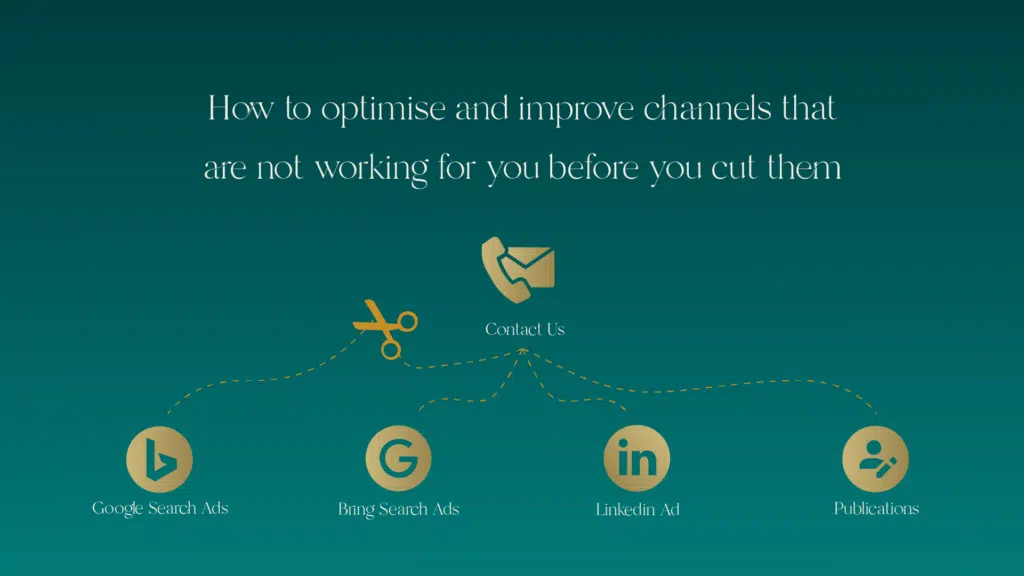
How to optimise and improve channels that are not working for you before you cut them
The landscape of digital advertising is ever evolving, making it common for marketers to encounter channels that seem to fall flat and fail to deliver desired results. However, before rash decisions are made, it’s best to consider optimising and improving the channel’s performance before cutting it:
1. Start broad, then narrow down
When venturing into a new advertising platform, it’s wise to initially cast the net wide. Create a broader target audience to test the waters. This approach allows you to gauge the platform’s potential reach and effectiveness without limiting your scope prematurely.
2. Review your creatives
One of the most critical aspects of advertising success is the quality of your creatives. Are your ads visually appealing and engaging? Do they effectively communicate your campaign’s benefits, pain points, and unique selling propositions (USPs)? Take a hard look at your creatives and ask if they are compelling enough to stop users in their tracks (or their scrolling) and interact with your content.
3. Refine audience and creatives
Once you’ve run your initial campaigns, closely analyse the data. What worked and what didn’t? Use the insights gained from your first foray into the platform to refine your target audience and creatives. This might involve adjusting demographics, interests, or even the tone, style, and content of your ad content.
4. Test from multiple angles
Don’t rely on a single approach. Test your audience segments and creatives from multiple angles. Experiment with different messaging, imagery, and ad formats. This diversified testing approach can reveal hidden opportunities for engagement and conversion.
5. Assess platform alignment
After audience and creative refinements, it’s time to question whether the platform aligns with your marketing funnel and objectives. Sometimes, the issue isn’t with your advertising but with the platform itself – perhaps the platform’s user base isn’t a good fit for your product or service, or maybe it’s not the right time and place for your creative content.
6. Give it time and patience
Instant success in advertising is rare. Instead of expecting immediate results, allocate a sufficient timeframe for testing and improvement. An 8 to 10-week period is often a reasonable amount of time to gauge a channel’s true potential through gathering data, making adjustments, and refining your strategy.
7. Evaluate brand relevance
Is your advertising on brand? Does it resonate with your brand identity and messaging? It’s crucial to maintain consistency across all marketing channels as inconsistencies can confuse potential customers and erode trust. Ensure that your creative content aligns with your brand’s values and personality to encourage user confidence and loyalty. By keeping style and content on brand but testing slight changes, you can closely monitor what marginal variations have the greatest impact. For example, we changed our client Akamai’s background colours from dark to light and this minor change resulted in CTR being improved by 7%! It’s a good example of how a minor change can have a major impact.
8. Analyse relevance and timing
Consider whether the channel is relevant to your target audience and your industry. Moreover, timing can play a significant role in a channel’s success. Are you reaching users when they are most likely to engage with your content? Analyse the optimal timing and frequency for your ads on the platform and follow the algorithm.
We recommend keeping a ‘conversion playbook’ which documents all variations made during the testing stage. By recording all of these ‘tests,’ you’ll have a document to look back at containing lessons on when and why to create a legacy, as well as past ideas that did or didn’t work. These valuable insights will inform your strategy moving forward.
Final thoughts…
To conclude, before you decide to cut ties with an underperforming advertising channel, take a step back and implement the strategic steps discussed. By starting broad and refining your audience and creatives, assessing platform alignment, and practicing patience, can often breathe new life into an underperforming channel. Remember that advertising success often requires persistence, adaptability, and a willingness to learn from your mistakes. By optimizing and improving your approach, you may very well turn an underperforming channel into a valuable asset in your marketing strategy.


